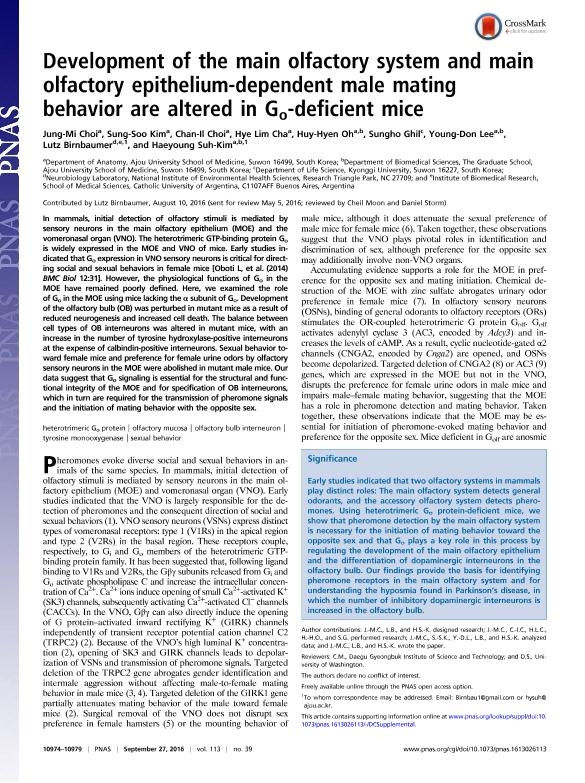Artículo
Development of the main olfactory system and main olfactory epithelium-dependent male mating behavior are altered in Go-deficient mice
Choi, Jung Mi; Kim, Sung Soo; Choi, Chan Il; Cha, Hye Lim; Oh, Huy Hyen; Ghil, Sungho; Lee, Young Don; Birnbaumer, Lutz ; Suh Kim, Haeyoung
; Suh Kim, Haeyoung
 ; Suh Kim, Haeyoung
; Suh Kim, Haeyoung
Fecha de publicación:
09/2016
Editorial:
National Academy of Sciences
Revista:
Proceedings of the National Academy of Sciences of The United States of America
ISSN:
0027-8424
Idioma:
Inglés
Tipo de recurso:
Artículo publicado
Clasificación temática:
Resumen
In mammals, initial detection of olfactory stimuli is mediated by sensory neurons in the main olfactory epithelium (MOE) and the vomeronasal organ (VNO). The heterotrimeric GTP-binding protein Go is widely expressed in the MOE and VNO of mice. Early studies indicated that Go expression in VNO sensory neurons is critical for directing social and sexual behaviors in female mice [Oboti L, et al. (2014) BMC Biol 12:31]. However, the physiological functions of Go in the MOE have remained poorly defined. Here, we examined the role of Go in the MOE using mice lacking the α subunit of Go. Development of the olfactory bulb (OB) was perturbed in mutant mice as a result of reduced neurogenesis and increased cell death. The balance between cell types of OB interneurons was altered in mutant mice, with an increase in the number of tyrosine hydroxylase-positive interneurons at the expense of calbindin-positive interneurons. Sexual behavior toward female mice and preference for female urine odors by olfactory sensory neurons in the MOE were abolished in mutant male mice. Our data suggest that Go signaling is essential for the structural and functional integrity of the MOE and for specification of OB interneurons, which in turn are required for the transmission of pheromone signals and the initiation of mating behavior with the opposite sex.
Archivos asociados
Licencia
Identificadores
Colecciones
Articulos(OCA HOUSSAY)
Articulos de OFICINA DE COORDINACION ADMINISTRATIVA HOUSSAY
Articulos de OFICINA DE COORDINACION ADMINISTRATIVA HOUSSAY
Citación
Choi, Jung Mi; Kim, Sung Soo; Choi, Chan Il; Cha, Hye Lim; Oh, Huy Hyen; et al.; Development of the main olfactory system and main olfactory epithelium-dependent male mating behavior are altered in Go-deficient mice; National Academy of Sciences; Proceedings of the National Academy of Sciences of The United States of America; 113; 39; 9-2016; 10974-10979
Compartir
Altmétricas



